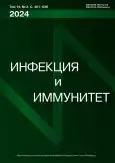Течение туберкулеза у мышей гаплотипа H2ᵛ, ассоциированного со сверхвысокой генетической восприимчивостью к инфекции
- Авторы: Байкузина П.Г.1,2, Горбачева Д.В.1,2, Апт А.С.1, Коротецкая М.В.1,3
-
Учреждения:
- ФГБНУ Центральный научно-исследовательский институт туберкулеза
- Сколковский институт науки и технологий
- Московский государственный университет имени М.В. Ломоносова
- Выпуск: Том 14, № 3 (2024)
- Страницы: 525-531
- Раздел: КРАТКИЕ СООБЩЕНИЯ
- URL: https://journal-vniispk.ru/2220-7619/article/view/262075
- DOI: https://doi.org/10.15789/2220-7619-TCO-16612
- ID: 262075
Цитировать
Полный текст
Аннотация
Генетические основы восприимчивости хозяина к патогену Mycobacterium tuberculosis (Mtb) и тяжесть течения инфекционного процесса изучены недостаточно. Поиск конкретных генов и зависимых от них иммунных реакций, влияющих на восприимчивость к туберкулезу, необходим для понимания механизмов патогенеза инфекционного процесса и определения мишеней для терапии инфекции, а также рационального конструирования новых вакцин. При работе с мышами линии B10.SM (H2ᵛ) мы показали, что эта линия проявляет очень высокую чувствительность к туберкулезной инфекции, при этом очень мало данных о структуре генома этой линии мышей, в том числе собственно гаплотипа H2ᵛ. Мы подобрали генетические маркеры Mit с длиной пробега в электрофорезе продуктов ПЦР, которые отличны у мышей линии B10.SM и конгенной по хромосоме 17 линии B10 (H2ᵇ), гораздо более резистентной к инфекции. В модели инфекции, вызванной введением путем ингаляции двух разных доз Mtb (100 и 600 КОЕ/мышь), мы установили, что срок жизни животных двух линий достоверно короче у мышей B10.SM, а уровень размножения микобактерий в легких у них достоверно выше. Мы показали (внутриклеточное окрашивание и ELISA), что продукция легочными клетками CD4⁺ IFNγ у зараженных животных полностью соответствует данным по фенотипу самой инфекции. Более резистентные мыши B10 отличаются более высоким содержание в легких IFNγ-положительных клеток и более высоким уровнем его секреции. При изучении влияния генетики хозяина на течение инфекционного процесса важно знать, по какому типу наследуется чувствительность и резистентность к заражению. Полученные нами данные показывают, что по времени выживания, размножению микобактерий в легких и выработке IFNγ гибриды (B10х B10.SM) F1 имеют промежуточный фенотип, то есть наследование идет по типу неполного доминирования. Эти данные были подтверждены сегрегационным анализом гибридов F2. Для более полного описания фенотипа линии B10.SM была проведена вакцинация животных BCG. Вакцинация достоверно снижала количество бактерий в легких после заражения и уровень легочной патологии, а также увеличивала продолжительность жизни животных, то есть высокая чувствительность к первичной инфекции не мешала эффективности вакцинации. Генетический и иммунологический анализ сверхчувствительной к туберкулезу линии мышей B10.SM будет продолжен, поскольку экспериментальные данные о причинах таких серьезных нарушений в защите от инфекции необходимы для понимания причин широкого спектра проявления заболевания в популяциях человека и рационального поиска новых вакцин и лекарств против туберкулеза.
Ключевые слова
Полный текст
Открыть статью на сайте журналаОб авторах
П. Г. Байкузина
ФГБНУ Центральный научно-исследовательский институт туберкулеза; Сколковский институт науки и технологий
Email: mkorotetskaya@gmail.com
лаборант-исследователь лаборатории иммуногенетики отдела иммунологии, лаборант
Россия, 107564, Москва, Яузская аллея, 2; МоскваД. В. Горбачева
ФГБНУ Центральный научно-исследовательский институт туберкулеза; Сколковский институт науки и технологий
Email: mkorotetskaya@gmail.com
лаборант-исследователь лаборатории иммуногенетики отдела иммунологии, студентка 6-го курса факультета биоинженерии и биоинформатики
Россия, 107564, Москва, Яузская аллея, 2; МоскваА. С. Апт
ФГБНУ Центральный научно-исследовательский институт туберкулеза
Email: mkorotetskaya@gmail.com
доктор биологических наук, профессор, зав. лабораторией иммуногенетики отдела иммунологии
Россия, 107564, Москва, Яузская аллея, 2Мария Валерьевна Коротецкая
ФГБНУ Центральный научно-исследовательский институт туберкулеза; Московский государственный университет имени М.В. Ломоносова
Автор, ответственный за переписку.
Email: mkorotetskaya@gmail.com
кандидат биологических наук, старший научный сотрудник лаборатории иммуногенетики отдела иммунологии, преподаватель факультета биоинженерии и биоинформатики
Россия, 107564, Москва, Яузская аллея, 2; МоскваСписок литературы
- Apt A.S., Avdienko V.G., Nikonenko B.V., Kramnik I.B., Moroz A.M., Skamene E. Distinct H-2 complex control of mortality, and immune responses to tuberculosis infection in virgin and BCG-vaccinated mice. Clin. Exp. Immunol., 1993, vol. 94, no. 2, pp. 322–329. doi: 10.1111/j.1365-2249.1993.tb03451.x
- Apt A.S., Logunova N.N., Kondratieva T.K. Host genetics in susceptibility to and severity of mycobacterial diseases. Tuberculosis (Edinb.), 2017, vol. 10⁶, pp. 1–8. doi: 10.1016/j.tube.2017.05.004
- Artzt K. Relationship of the murine t-haplotypes and the H-2 complex. Surv. Immunol. Res., 1983, vol. 2, no. 3, pp. 278–280. doi: 10.1007/BF02918431
- Cooper A.M. Cell-mediated immune responses in tuberculosis. Annu. Rev. Immunol., 2009, vol. 27, pp. 393–422. doi: 10.1146/annurev.immunol.021908.132703
- Kramnik I.B., Dietrich W.F., Demant P., Bloom B.R. Genetic control of resistance to experimental infection with virulent Mycobacterium tuberculosis. Proc. Natl Acad. Sci. USA, 2000, vol. 97, no. 15, pp. 8560–8565. doi: 10.1073/pnas.150227197
- Lyadova I.V., Eruslanov E.B., Khaidukov S.V., Yeremeev V.V., Majorov K.B., Pichugin A.V., Nikonenko B.V., Kondratieva T.K., Apt A.S. Comparative analysis of T lymphocytes recovered from the lungs of mice genetically susceptible, resistant, and hyperresistant to Myco bacterium tuberculosis-triggered disease. J. Immunol., 2000, vol. 165, no. 10, pp. 5921–5931. doi: 10.4049/jimmunol.165.10.5921
- Radaeva T.V., Kondratieva E.V., Sosunov V.V., Majorov K.B., Apt A.S. A human-like TB in genetically susceptible mice followed by the true dormancy in a Cornell-like model. Tuberculosis (Edinb.), 2008, vol. 88, no 6, pp. 576–585. doi: 10.1016/j.tube.2008.05.003
- Radaeva T.V., Nikonenko B.V., Mischenko V.V., Averbakh M.M.Jr., Apt A.S. Direct comparison of low-dose and Cornell-like models of chronic and reactivation tuberculosis in genetically susceptible I/St and resistant B6 mice. Tuberculosis (Edinb.), 2005, vol. 85, no. 1-2, pp. 65–72. doi: 10.1016/j.tube.2004.09.014
- Snell G.D. Congenic resistant strains of mice. In: Origins of Inbred Mice. Ed. by H.C. Morse. New York: Academic Press, 1978.
- Wolrd Health Organization. Global tuberculosis report 2023. URL: https://www.who.int/teams/global-tuberculosis-programme/tb-reports/global-tuberculosis-report-2023
Дополнительные файлы










